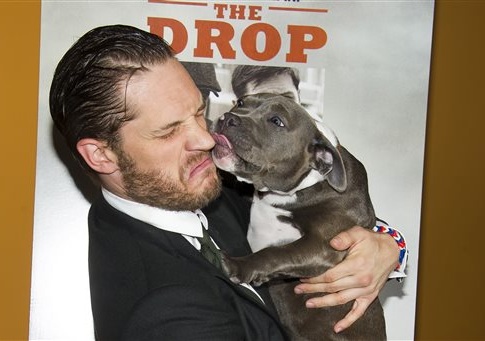It’s the simplest things that remind you of film’s primacy as a visual medium, things that simply don’t translate well to the written word: images of leaves of grass blowing in the wind, a subtle shift in lighting that darkens or brightens a mood. We feel these moments more than we actually notice them, letting the beauty or the dread sink into our gut as the images wash over our eyes.
I mention this because the most effective part of The Drop isn’t the twisty plot or the A-plus performances from A-plus actors. It’s a puppy.
The puppy is found by Bob (Tom Hardy) in Nadia’s (Noomi Rapace) trashcan, bleeding from the head. Someone has beaten it and thrown it away. Bob and Nadia, strangers until he hears the pup’s cries, clean the puppy’s wounds. Bob, who tends a mob-owned bar for his cousin Marv (James Gandolfini), grows close to Nadia as the couple trains the rescued pitbull.
The dog is so cute, it elicited an almost physical reaction from the audience I saw The Drop with. Patrons literally "awwwwed" when they first got a good look at little Rocco. The dog had all the proportions of "cuteness": oversized facial features and paws with a head slightly too big for his body. Don’t question it. It’s science.
"Cute cuts through all layers of meaning and says, Let's not worry about complexities, just love me," Denis Dutton, the original proprietor of Arts and Letters Daily and the author of The Art Instinct: Beauty, Pleasure, and Human Evolution, told the New York Times a few years back. Many, including Dutton, have posited that this visceral reaction is hardwired into our brain, sparking feelings of protectiveness.
Seeing cute Rocco onscreen—as opposed to, say, reading about him on the page—disarms the viewer. So when Eric (Matthias Schoenaerts), a thuggish former boyfriend of Nadia’s, threatens violence against the dog, we experience an emotional, irrational response.
The complexities of story and motive are dismissed. We want the heretofore calm, almost dimwitted Bob to man up, to defend his newfound friend. And such a response implicates us in every bit of violence that transpires in the film’s third act. It is the best kind of filmmaking, the sort that wraps the viewer into the world onscreen.
I feel a little bad going on at such length about the affecting manipulations of director Michael R. Roskam, given that this is Gandolfini’s last film. He is, of course, quite good in the role of the washed up ex-hood who has been muscled off his turf by the new, scarier kids on the block. He resents being forced to serve as a "drop bar"—a venue where hoods drop off their bookmaking money and other ill-gotten revenue—for a gang of Chechen toughs. That resentment leads him down some dark alleys.
Hardy turns in his second strong performance of the year (the first is in Locke). It’s a different sort of role, more subdued yet no less accomplished. Hardy’s stoic sensibility and quiet humor make the big third act reveal believable. Without his subtle confidence, it might not have worked.
The Drop is surprisingly funny, given the rather grim nature of its setting and participants. While a bit of levity is always welcome, it does render the film somewhat uneven. It is not a pure crime drama, nor pure black comedy, nor a mixture of both. But it’s quite entertaining and well worth checking out.
